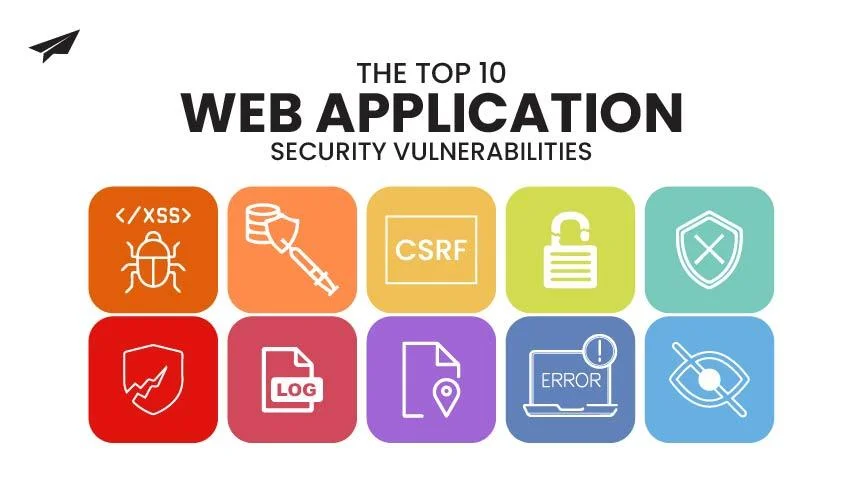The Top 10 Web Application Security Vulnerabilities
Web application security is one of the core aspects of cyber security. Unfortunately, cybersecurity does not get the attention it deserves. Many developers tend to focus on applications’ aesthetics, functionality, and performance. This inevitably means that they deprioritize cybersecurity. This blog post emphasizes the importance of web application security and lists the top 10 vulnerabilities.
What is Web Application Security?
Web application security involves minimizing vulnerabilities to your software, making it immune to a range of cyber threats. The goal of web application security is to prevent security breaches, protect sensitive information, and maintain the integrity and availability of web applications. Almost everything of strategic and economic importance today uses some software application. Your Instagram account, for example, is also a web-based application. Web application security is crucial for protecting businesses and users from cyber threats and attacks. However, the impact of the security breach can be significant. Web applications often collect and store sensitive information, such as personal details, credit card information, and login credentials. Without proper security measures in place, this information can be vulnerable to theft and misuse. Not just that, a security breach in a web application can damage a company’s reputation and lead to a loss of customer trust. This can have a significant impact on a business’s bottom line.
One well-known example of the impact of not having web application security is the Equifax data breach. In 2017, Equifax, one of the largest credit reporting agencies in the world, announced that it had suffered a data breach that compromised the personal information of millions of customers. The breach was caused by a vulnerability in Equifax’s web application software, which allowed attackers to access sensitive information such as Social Security numbers, birth dates, addresses, and driver’s license numbers. The breach resulted from Equifax failing to apply a critical security patch to its web application, despite the patch being available for several months before the attack. The impact of the Equifax data breach was significant. Equifax faced numerous lawsuits and investigations and a loss of trust from its customers. The company also incurred substantial costs to offer identity theft protection and credit monitoring services to affected customers. In addition, the credit reporting agency’s stock price took a significant hit following the breach, causing a financial loss for shareholders.
This case serves as a cautionary tale of the importance of web application security. By failing to apply a critical security patch, Equifax exposed the sensitive information of millions of customers to theft and misuse. The cost of not having proper web application security measures in place can be high, both in terms of financial losses and damage to a company’s reputation. More information about the Equifax data breach incident is available here.
Web Application Security Vulnerabilities
Here is an overview of the top 10 web application security vulnerabilities:
1. Cross-Site Scripting (XSS)
A type of attack that injects malicious code into a web page viewed by other users. XSS attacks can steal sensitive information, such as login credentials, and can even allow attackers to take control of the affected user’s web session.
2. SQL Injection
An attack that manipulates a web application database. It involves the database by injecting malicious SQL code. SQL injection attacks can result in sensitive information being leaked or stolen and damage the web application’s underlying database. In web application development, we can prevent SQL injection attacks by adequately sanitizing user input and using prepared statements to avoid malicious code from being executed in the database.
3. Cross-Site Request Forgery (CSRF)
A type of attack that tricks a user into performing an unintended action on a web application. CSRF attacks can be used to steal sensitive information, such as login credentials, or to perform unauthorized actions on behalf of the affected user.
4. Broken Authentication and Session Management
Attackers take over a user’s session and gain unauthorized access to sensitive information. This can occur due to weak passwords, unsecured session IDs, and other authentication-related issues.
5. Insecure Direct Object References
Insecure Direct Object Reference vulnerability occurs when a web application allows users to access sensitive information directly by manipulating a parameter in a URL.
6. Broken Access Control
A security vulnerability that allows unauthorized users to access restricted parts of a web application. This can occur when a web application does not correctly implement access control checks, such as user authentication and authorization.
7. Insufficient Logging and Monitoring
This is a type of security vulnerability that makes it difficult to detect and respond to security incidents. Inefficient logging and monitoring can result in security breaches going unnoticed for extended periods.
8. Local File Inclusion Vulnerability
LSI vulnerability allows the attacker to access sensitive information. Web applications are hosted on a server like Linux or Windows that contains important information like log files, OS files and configuration. LFI attacks are commonly used to target web servers running PHP, as PHP provides a lot of functions that make it easy to include local files. However, any web application that allows user input to be used to specify the name or location of a file that is to be included and executed can be vulnerable to LFI attacks. To carry out an LFI attack, the attacker typically needs to first identify a vulnerable web application and then craft a malicious input that will be used to include and execute a malicious file. This is often done by using special characters or encoding techniques in the input to bypass input validation checks and trick the web application into accessing the wrong file.
9. Security Misconfiguration
Security misconfiguration can lead to serious security incidents, such as data breaches and unauthorized access to sensitive information. It happens when a web application’s security settings or controls are set up incorrectly, which can leave the application open to attacks.
10. Failure to Restrict URL Access
A security vulnerability that allows attackers to access sensitive parts of a web application by bypassing normal access controls. This can occur when a web application does not properly restrict access to sensitive URLs, such as administrative pages.

Cloud Web Security
Cloud web security is critical for organizations leveraging the cloud for their IT needs. In the cloud, data is stored and processed on a shared infrastructure managed by a third-party cloud service provider. As a result, organizations must ensure that their data is protected against unauthorized access, theft, and tampering. Organizations are taking security measures such as encryption, adherence of the cloud service provider to relevant compliance and regulatory requirements, etc., to ensure the security of cloud-based applications and data.
Key Takeaways
Web security is an important concern for companies that rely on the internet to conduct business and store sensitive information. Therefore, organizations must regularly assess their systems to identify and address application vulnerabilities before attackers can exploit them. By understanding these top 10 web application security vulnerabilities, organizations can take steps to protect their web applications and prevent security breaches. This includes implementing security measures such as encryption, secure coding practices, incident response planning, and educating users on safe web usage practices.






